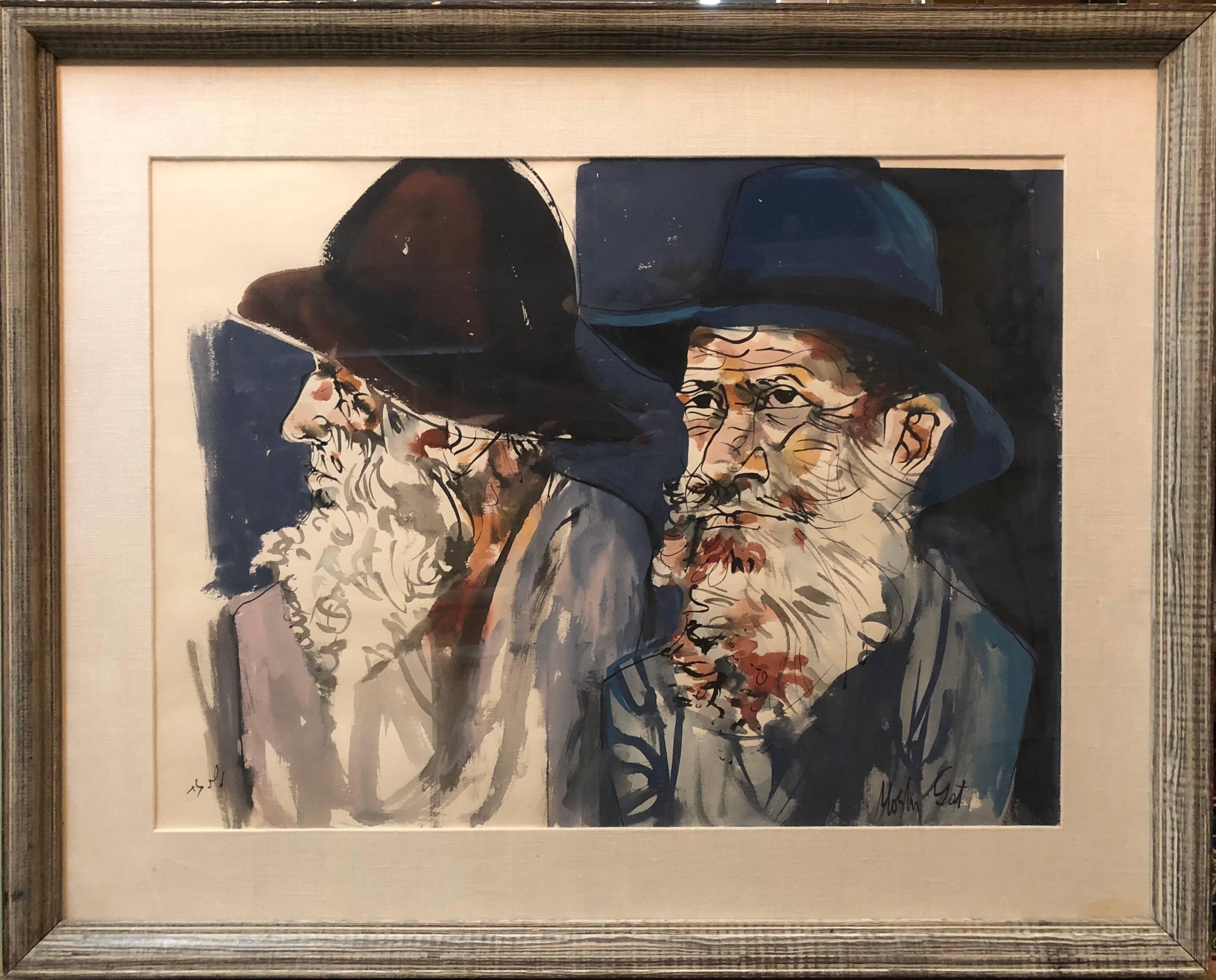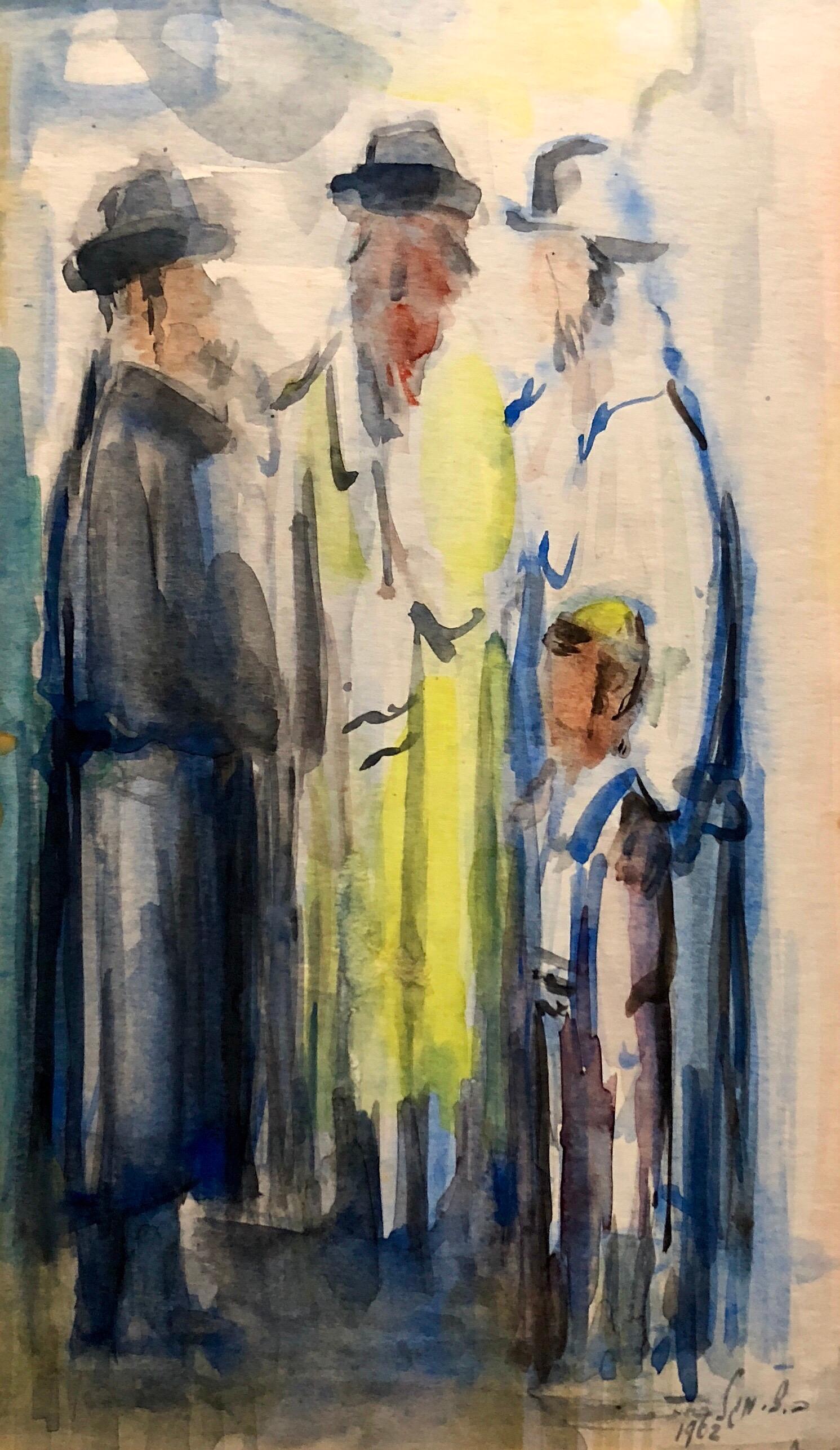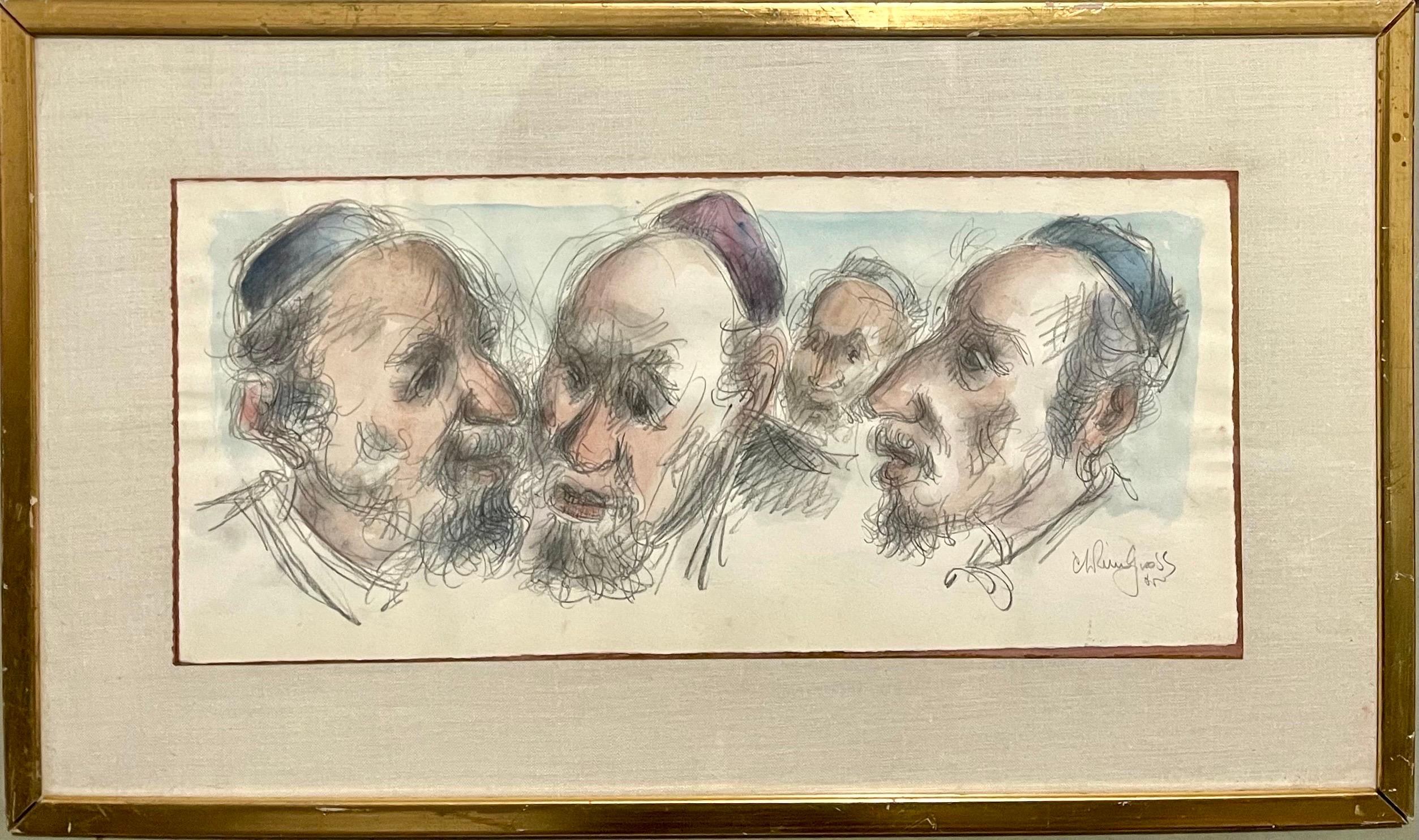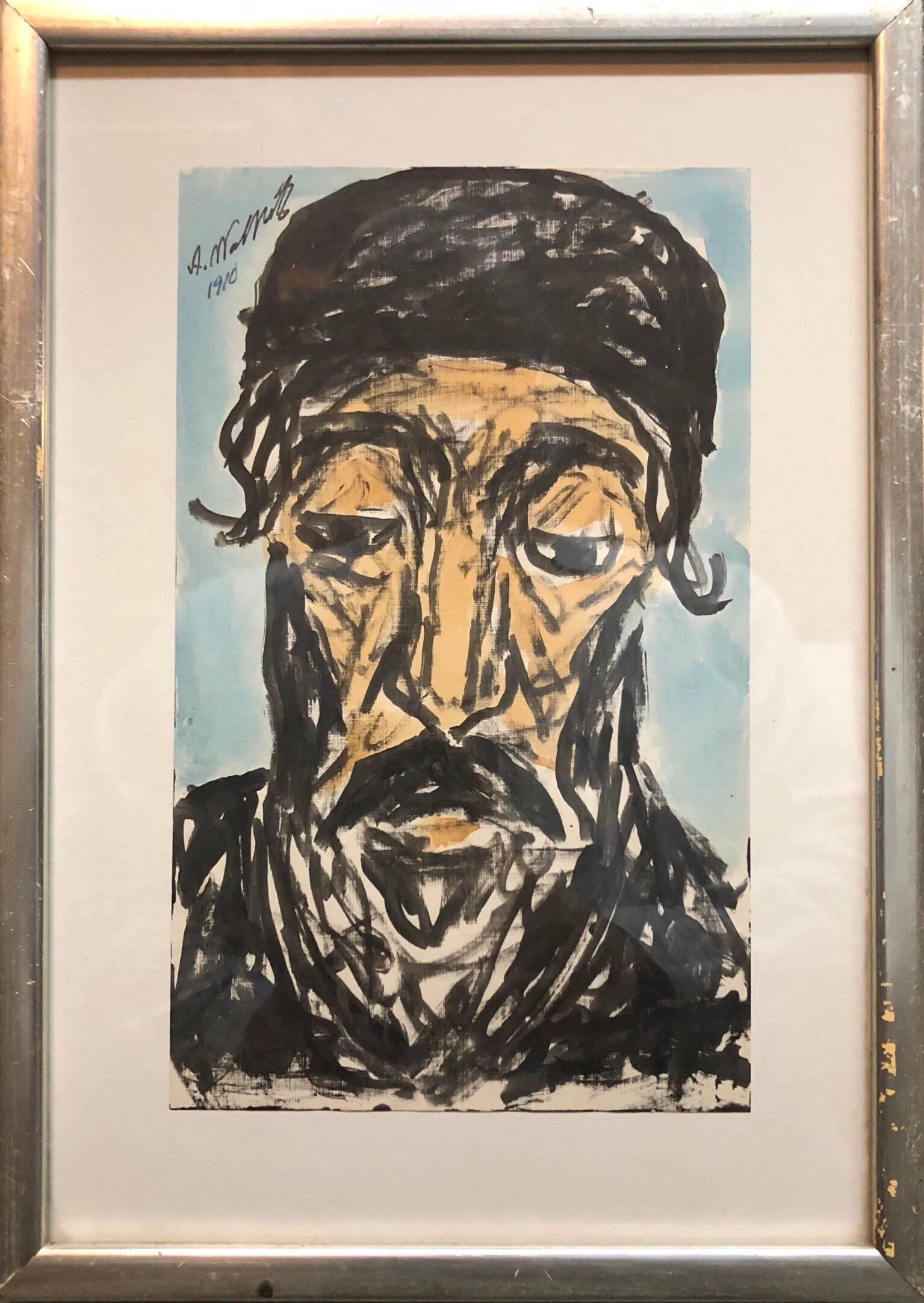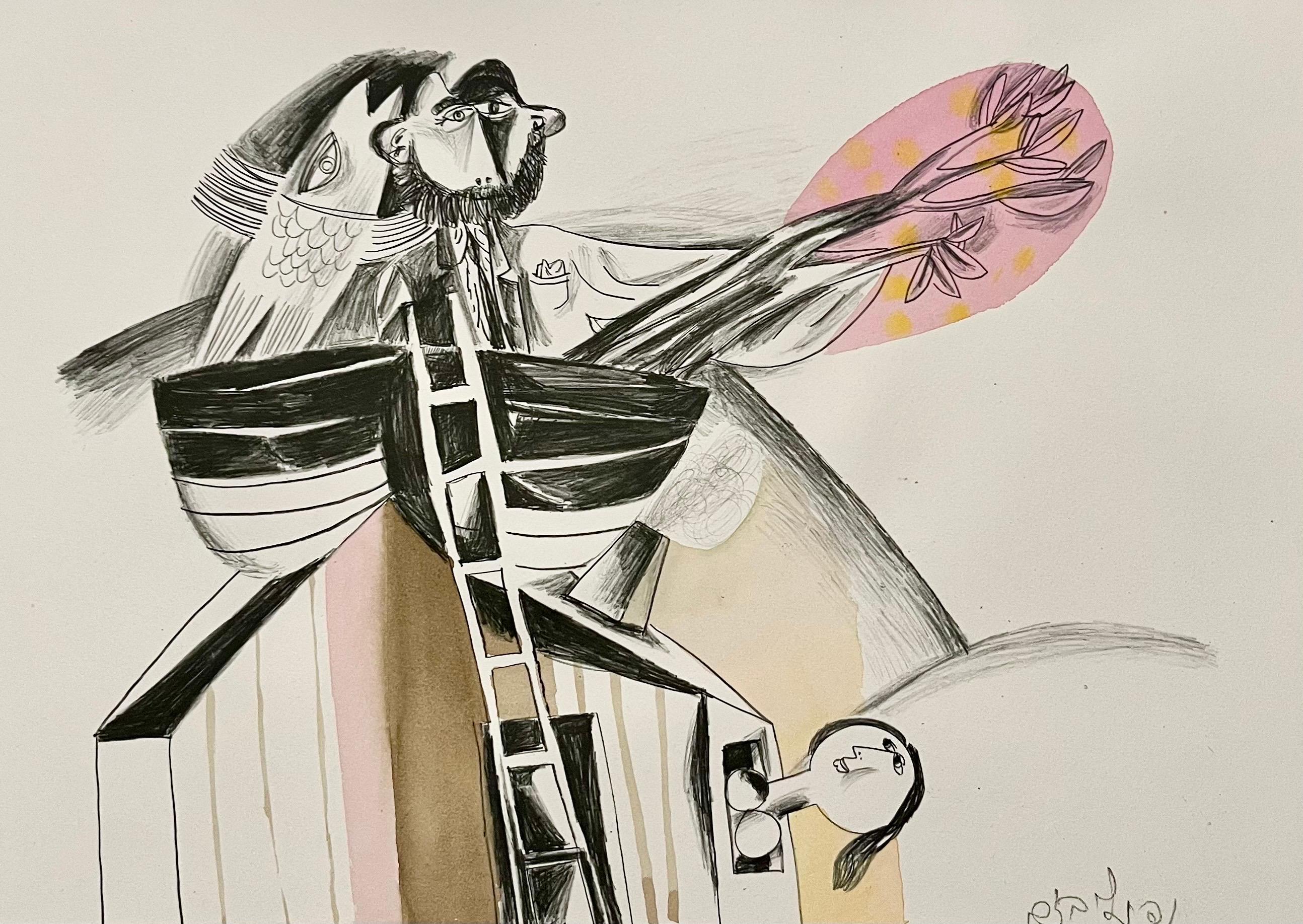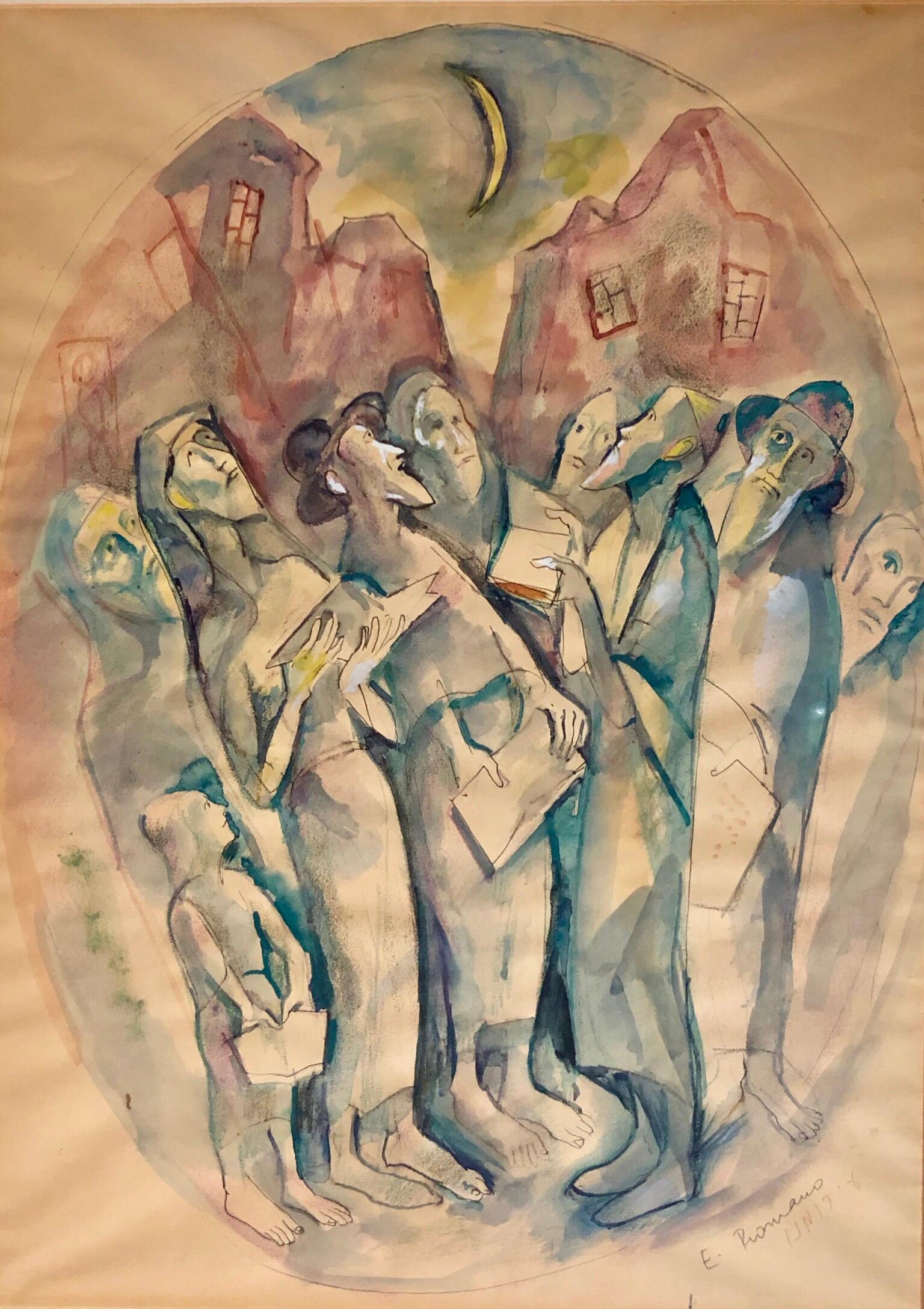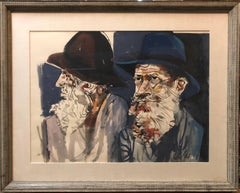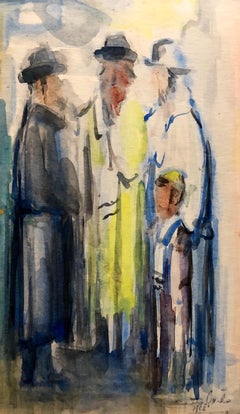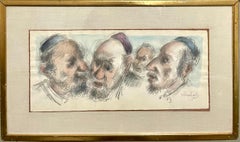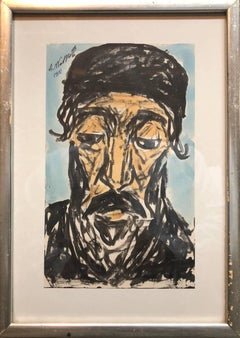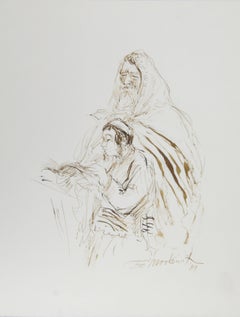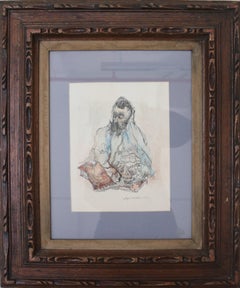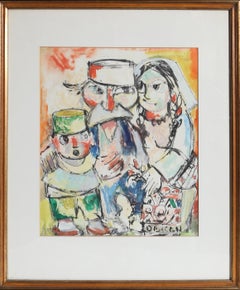Items Similar to Large Watercolor Painting Israeli Modernist Judaica Rabbi with Children, Bezalel
Want more images or videos?
Request additional images or videos from the seller
1 of 11
Moshe GatLarge Watercolor Painting Israeli Modernist Judaica Rabbi with Children, Bezalelc.1960
c.1960
$2,200
£1,669.31
€1,908.71
CA$3,072.80
A$3,416.54
CHF 1,783.93
MX$41,587.60
NOK 22,762.15
SEK 21,327.05
DKK 14,245.02
Shipping
Retrieving quote...The 1stDibs Promise:
Authenticity Guarantee,
Money-Back Guarantee,
24-Hour Cancellation
About the Item
A large watercolor painting.
Moshe Gat was born in Haifa in 1935.
in 1952 he began his studies at the Bezalel School, in Jerusalem.
In 1955 he returned to Haifa, where he taught drawing, and began to participate in important exhibitions being shown in Israel.
In 1957 he was awarded a grant by the America-Israel Cultural Fund, to further his studies abroad. He became a member of the Society of Painters and Sculptors in Israel, and held his first one-man exhibitions. The most important of these was in the Tel-Aviv Museum.
In 1958 he left Israel, and after an educational tour of the museums of Paris and Italy, he reached Mexico. Several months later, two of his works were accepted for the exhibition of artists of Mexico; this was part of the American Biannual, which brought together in the city the best of American art. Here, the Director of the National Museum of Modern Art saw the pictures and arranged a one-man show for Gat at the Museum of the Palace of Fine Arts in Mexico City.
In 1962 he held his first one man show at the ACA. Gallery in New York. He held exhibits too in New Orleans, Chicago, Detroit, Texas and elsewhere.
In 1962, after an absence of five years, the artist returned to Israel, and settled in Haifa. In the following year he held exhibitions at the Haifa Municipal Museum, the Bezalel Museum in Jerusalem, the Artist's House in Haifa, and Jerusalem, the Chermerinsky Gallery in Tel Aviv, and other places all over the country. These exhibitions mainly included works produced abroad, many of which were borrowed from private collections. In 1962 he began to teach drawing at the Bezalel School in Jerusalem.
The First Exhibition of Israeli Graphic-Art, Museum for Modern Art, Haifa, 1967.
Artists: Ullman, Micha Steinhardt, Jakob Rothman, Aryeh Pins, Jacob Smilansky, Noemi Sima, Miron Moreh, Mordecai Lehmann, Rudolph (Rudi) Lahav-Shaaltiel, Ora Yaskil, Avraham Tamir, Moshe Weiss, Joseph Hoffman, Moshe Gat, Moshe Gross, Michael Glass, Ari Bacon, Yehuda Ben Shaul, David (Dedi) Beeri, Tuvia Aschheim, Isidor
Moshe Gat took part in the international exhibition at the Metropolitan Fine Art Gallery in Tokyo, where his woodcut "Three Old Women" won the prize for graphic art.
He was one of the twelve Israeli artists whose works were shown also at an exhibition held at Pushkin House in Moscow, early in 1965.
In 1965 he exhibited at the "Mer Kup" Gallery in Mexico City.
- Creator:Moshe Gat (1935)
- Creation Year:c.1960
- Dimensions:Height: 40.5 in (102.87 cm)Width: 33 in (83.82 cm)
- Medium:
- Movement & Style:
- Period:
- Condition:frame has minor wear.
- Gallery Location:Surfside, FL
- Reference Number:1stDibs: LU38213146432
About the Seller
4.9
Platinum Seller
Premium sellers with a 4.7+ rating and 24-hour response times
Established in 1995
1stDibs seller since 2014
1,784 sales on 1stDibs
Typical response time: <1 hour
- ShippingRetrieving quote...Shipping from: Surfside, FL
- Return Policy
Authenticity Guarantee
In the unlikely event there’s an issue with an item’s authenticity, contact us within 1 year for a full refund. DetailsMoney-Back Guarantee
If your item is not as described, is damaged in transit, or does not arrive, contact us within 7 days for a full refund. Details24-Hour Cancellation
You have a 24-hour grace period in which to reconsider your purchase, with no questions asked.Vetted Professional Sellers
Our world-class sellers must adhere to strict standards for service and quality, maintaining the integrity of our listings.Price-Match Guarantee
If you find that a seller listed the same item for a lower price elsewhere, we’ll match it.Trusted Global Delivery
Our best-in-class carrier network provides specialized shipping options worldwide, including custom delivery.More From This Seller
View AllLarge Watercolor Painting Israeli Modernist Judaica Two Rabbis
By Moshe Gat
Located in Surfside, FL
A large watercolor painting.
Moshe Gat was born in Haifa in 1935.
in 1952 he began his studies at the Bezalel School, in Jerusalem.
In 1955...
Category
Mid-20th Century Expressionist Figurative Drawings and Watercolors
Materials
Paper, Watercolor
Israeli Judaica Watercolor Gouache Bar Mitzvah Boy Rabbi Painting Russian Artist
By Ben Zion Magal
Located in Surfside, FL
Ben Zion Magal (1908 - 1999)
Ben Zion Magal was born in 1908 in Kishinev - Russia and there, years later, graduated from the Art Academy. He arrived to Erertz Israel together with hi...
Category
1960s Neo-Expressionist Figurative Paintings
Materials
Watercolor, Gouache
Chaim Gross Mid Century Mod Judaica Jewish Watercolor Painting Rabbis WPA Artist
By Chaim Gross
Located in Surfside, FL
Chaim Gross (American, 1904-1991)
Watercolor painting
Rabbinical Talmudic Discussion
Hand signed
17 x 29 framed, paper 10 x 22
Chaim Gross (March 17, 1904 – May 5, 1991) was an American modernist sculptor and educator.
Gross was born to a Jewish family in Austrian Galicia, in the village of Wolowa (now known as Mezhgorye, Ukraine), in the Carpathian Mountains. In 1911, his family moved to Kolomyia (which was annexed into the Ukrainian USSR in 1939 and became part of newly independent Ukraine in 1991). When World War I ended, Gross and brother Avrom-Leib went to Budapest to join their older siblings Sarah and Pinkas. Gross applied to and was accepted by the art academy in Budapest and studied under the painter Béla Uitz, though within a year a new regime under Miklos Horthy took over and attempted to expel all Jews and foreigners from the country. After being deported from Hungary, Gross began art studies at the Kunstgewerbeschule in Vienna, Austria shortly before immigrating to the United States in 1921. Gross's studies continued in the United States at the Beaux-Arts Institute of Design, where he studied with Elie Nadelman and others, and at the Art Students League of New York, with Robert Laurent. He also attended the Educational Alliance Art School, studying under Abbo Ostrowsky, at the same time as Moses Soyer and Peter Blume.
In 1926 Gross began teaching at The Educational Alliance, and continued teaching there for the next 50 years. Louise Nevelson was among his students at the Alliance (in 1934), during the time she was transitioning from painting to sculpture. In the late 1920s and early 1930s he exhibited at the Salons of America exhibitions at the Anderson Galleries and, beginning in 1928, at the Whitney Studio Club. In 1929, Gross experimented with printmaking, and created an important group of 15 linocuts and lithographs of landscapes, New York City streets and parks, women in interiors, the circus, and vaudeville. The entire suite is now in the collection of the Philadelphia Museum of Art. Gross returned to the medium of printmaking in the 1960s, and produced approximately 200 works in the medium over the next two decades. For more than sixty years Chaim Gross's art has expressed optimistic, affirming themes, Judaica, balancing acrobats, cyclists, trapeze artists and mothers and children convey joyfulness, modernism, exuberance, love, and intimacy. This aspect of his work remained consistent with his Jewish Hasidic heritage, which teaches that only in his childlike happiness is man nearest to God.
In March 1932 Gross had his first solo exhibition at Gallery 144 in New York City. For a short time they represented Gross, as well as his friends Milton Avery, Moses Soyer, Ahron Ben-Shmuel and others.
Gross was primarily a practitioner of the direct carving method, with the majority of his work being carved from wood. Other direct carvers in early 20th-century American art include William Zorach, Jose de Creeft, and Robert Laurent. Works by Chaim Gross can be found in major museums and private collections throughout the United States, with substantial holdings (27 sculptures) at the Hirshhorn Museum and Sculpture Garden. A key work from this era, now at the Smithsonian American Art Museum, is the 1932 birds-eye maple Acrobatic Performers, which is also only one and one quarter inch thick.
In 1933 Gross joined the government's PWAP (Public Works of Art Project), which transitioned into the WPA (Works Progress Administration), which Gross worked for later in the 1930s. Under these programs Gross taught and demonstrated art, made sculptures that were placed in schools and public colleges, made work for Federal buildings including the Federal Trade Commission Building, and for the France Overseas and Finnish Buildings at the 1939 New York World's Fair. Gross was also recognized during these years with a silver medal at the Exposition universelle de 1937 in Paris, and in 1942, with a purchase prize at the Metropolitan Museum of Art's "Artists for Victory" exhibition for his wood sculpture of famed circus performer Lillian Leitzel.
In 1949 Gross sketched Chaim Weizmann, Israeli President, at several functions in New York City where Weizmann was speaking, Gross completed the bust in bronze later that year. Gross returned to Israel for three months in 1951 (the second of many trips there in the postwar years) to paint a series of 40 watercolors of life in various cities. This series was exhibited at the Jewish Museum (Manhattan) in 1953. He also did some important Hebrew medals.
In the 1950s Gross began to make more bronze sculptures alongside his wood and stone pieces, and in 1957 and 1959 he traveled to Rome to work with famed bronze foundries including the Nicci foundry. At the end of the decade Gross was working primarily in bronze which allowed him to create open forms, large-scale works and of course, multiple casts. Gross's large-scale bronze The Family, donated to New York City in 1991 in honor of Mayor Ed Koch, and installed at the Bleecker Street Park at 11th street, is now a fixture of Greenwich Village. In 1959, a survey of Gross's sculpture in wood, stone, and bronze was featured in the exhibit Four American Expressionists curated by Lloyd Goodrich at the Whitney Museum of American Art, with work by Abraham Rattner, Doris Caesar, and Karl Knaths. In 1976, a selection from Gross's important collection of historic African sculpture, formed since the late 1930s, was exhibited at the Worcester Art Museum in the show The Sculptor's Eye: The African Art Collection of Mr. and Mrs. Chaim Gross. Gross was elected into the National Academy of Design as an Associate member, and became a full Academician in 1981. In 1984, he was inducted into the American Academy of Arts and Letters, with Jacob Lawrence and Lukas Foss. In the fall of 1991, Allen Ginsberg gave an important tribute to Gross at the American Academy of Arts and Letters, which is published in their Proceedings. In 1994, Forum Gallery, which now represents the Chaim Gross estate, held a memorial exhibition featuring a sixty-year survey of Gross's work.In March 1932 Gross had his first solo exhibition at Gallery 144 in New York City. For a short time they represented Gross, as well as his friends Milton Avery, Moses Soyer, Ahron Ben-Shmuel and others.
Gross was primarily a practitioner of the direct carving method, with the majority of his work being carved from wood. Other direct carvers in early 20th-century American art include William Zorach, Jose de Creeft, and Robert Laurent. Works by Chaim Gross can be found in major museums and private collections throughout the United States, with substantial holdings (27 sculptures) at the Hirshhorn Museum and Sculpture Garden. A key work from this era, now at the Smithsonian American Art Museum, is the 1932 birds-eye maple Acrobatic Performers, which is also only one and one quarter inch thick.
In 1933 Gross joined the government's PWAP (Public Works of Art Project), which transitioned into the WPA (Works Progress Administration), which Gross worked for later in the 1930s. Under these programs Gross taught and demonstrated art, made sculptures that were placed in schools and public colleges, made work for Federal buildings including the Federal Trade Commission Building, and for the France Overseas and Finnish Buildings at the 1939 New York World's Fair. Gross was also recognized during these years with a silver medal at the Exposition universelle de 1937 in Paris, and in 1942, with a purchase prize at the Metropolitan Museum of Art's "Artists for Victory" exhibition for his wood sculpture of famed circus performer Lillian Leitzel.
In 1949 Gross sketched Chaim Weizmann, President of Israel, at several functions in New York City where Weizmann was speaking, Gross completed the bust in bronze later that year. Gross returned to Israel for three months in 1951 (the second of many trips there in the postwar years) to paint a series of 40 watercolors of life in various cities. This series was exhibited at the Jewish Museum (Manhattan) in 1953.
In the 1950s Gross began to make more bronze sculptures alongside his wood and stone pieces, and in 1957 and 1959 he traveled to Rome to work with famed bronze foundries including the Nicci foundry. At the end of the decade Gross was working primarily in bronze which allowed him to create open forms, large-scale works and of course, multiple casts. Gross's large-scale bronze The Family, donated to New York City in 1991 in honor of Mayor Ed Koch, and installed at the Bleecker Street Park at 11th street, is now a fixture of Greenwich Village. In 1959, a survey of Gross's sculpture in wood, stone, and bronze was featured in the exhibit Four American Expressionists curated by Lloyd Goodrich at the Whitney Museum of American Art, with work by Abraham Rattner, Doris Caesar, and Karl Knaths. In 1976, a selection from Gross's important collection of historic African sculpture, formed since the late 1930s, was exhibited at the Worcester Art Museum in the show The Sculptor's Eye: The African Art Collection of Mr. and Mrs. Chaim Gross. Gross was elected into the National Academy of Design as an Associate member, and became a full Academician in 1981. In 1984, he was inducted into the American Academy of Arts and Letters, with Jacob Lawrence and Lukas Foss. In the fall of 1991, Allen Ginsberg gave an important tribute to Gross at the American Academy of Arts and Letters, which is published in their Proceedings. In 1994, Forum Gallery, which now represents the Chaim Gross estate, held a memorial exhibition featuring a sixty-year survey of Gross's work.
Gross was a professor of printmaking and sculpture at both the Educational Alliance and the New School for Social Research in New York City, as well as at the Brooklyn Museum Art School, the MoMA art school, the Art Student's League and the New Art School (which Gross ran briefly with Alexander Dobkin...
Category
Mid-20th Century American Modern Figurative Drawings and Watercolors
Materials
Watercolor, Paper
Modernist Watercolor Painting, Portrait of a Man, Judaica Rabbi
By Abraham Walkowitz
Located in Surfside, FL
Abraham Walkowitz (March 28, 1878 - January 27, 1965) was an American painter grouped in with early American Modernists working in the Modernist style.
Walkowitz was born in Tyumen, Siberia to Jewish parents. He emigrated with his mother to the United States in his early childhood. He studied at the National Academy of Design in New York City and the Académie Julian in Paris under Jean-Paul Laurens. Walkowitz and his contemporaries later gravitated around photographer Alfred Stieglitz's 291 Gallery, originally titled the Little Galleries of the Photo-Secession, where the forerunners of modern art in America gathered and where many European artists were first exhibited in the United States. During the 291 years, Walkowitz worked closely with Stieglitz as well as Arthur Dove, Marsden Hartley, and John Marin (often referred to as "The Stieglitz Quartet").
Early Career and Training
Portrait of Abraham Walkowitz - 1907 - Max Weber - Brooklyn Museum
Walkowitz was drawn to art from childhood. In a 1958 oral interview with Abram Lerner...
Category
Early 20th Century Modern Figurative Drawings and Watercolors
Materials
Paper, Watercolor
Rare Israeli Modernist Judaica Watercolor Painting on Lithograph Naftali Bezem
By Naftali Bezem
Located in Surfside, FL
Naftali Bezem (Hebrew: נפתלי בזם; born November 27, 1924) is an Israeli painter, muralist, and sculptor.
Bezem was born in Essen, Germany, in 1924. His early adolescence was spent ...
Category
1970s Modern Figurative Drawings and Watercolors
Materials
Watercolor, Lithograph
Modernist Watercolor Painting Judaica Kiddush Levana Blessing New Moon
By Emanuel Glicenstein Romano
Located in Surfside, FL
Genre: Judaic prayer scene
Subject: Landscape
Medium: watercolor
Surface: Paper
Country: United States
EMANUEL ROMANO
Rome, Italy, b. 1897, d. 1984
Emanuel Glicenstein Romano was born in Rome, September 23, 1897.
His father Henryk Glicenstein was a sculptor and was living in Rome with his wife Helena (born Hirszenberg) when Emanuel was born his father obtained Italian citizenship and adopted the name Enrico. Emanuel was brought up in Italy, Switzerland, Germany, England and Poland.
In 1926 Emanuel and his father sailed for New York. They briefly visited Chicago. Romano's sister, Beatrice, and mother only joined them in New York years later.
Romano changed his name on his arrival to America and some have erroneously speculated that this was to avoid antisemitic anti Jewish discrimination. In truth, as the son of a highly-regarded artist, Romano changed his name to ensure that any success or recognition he would later attain, would be the result of nothing other than his own merit as an artist, and not on account of his father's fame.
In 1936 Romano was worked for the Federal Art Project creating murals. During and immediately after World War II, Romano created a series of allegorical works depicting graphic holocaust images that were held closely by the family until after his passing. One of these works is now on permanent display in the Florida Holocaust Museum in St. Petersburg Florida.
Emanuel's father died in 1942 in a car accident before they could realize their shared dream of visiting Israel.
In 1944 Romano, having completed his degree at the Pennsylvania Academy of Fine Arts and the Art Institute of Chicago, began teaching at the City College of New York.
Romano moved to Safed, Israel in 1953 and established an art museum in his father's memory, the Glicentein Museum.
COLLECTIONS
Indianapolis Museum of Art
Metropolitan Museum of Art
Boston Fine Arts Museum
Fogg Museum
Musée Nacional de France
Recently his work has been added to the Florida Holocaust Museum collection. His notable works include his holocaust themed allegorical paintings as well as portraits of Marianne Moore, his father and William Carlos Williams...
Category
20th Century American Modern Figurative Paintings
Materials
Paper, Watercolor
You May Also Like
Jewish Family
By Boris Deutsch
Located in San Francisco, CA
This artwork "Jewish Family" 1968 is an acrylic and ink on wove paper by noted Lithuanian artist Boris Deutsch, 1892-1978. It is hand signed and dated at the lower left corner by the...
Category
Mid-20th Century Expressionist Figurative Drawings and Watercolors
Materials
Ink, Acrylic
Rabbi with Student, Folk Art Ink on Paper by Ira Moskowitz
By Ira Moskowitz
Located in Long Island City, NY
Ira Moskowitz, Polish/American (1912 - 2001) - Rabbi with Student, Year: 1989, Medium: Ink on Paper, signed, Size: 13 in. x 10 in. (33.02 cm x 25.4 cm), Description: Reading togeth...
Category
1980s Folk Art Figurative Drawings and Watercolors
Materials
Ink
Untitled (Rabbi Scholar)
By Seymour Rosenthal
Located in New York, NY
Seymour Rosenthal (American 1921-2007) "Untitled: Rabbi Scholar", Figurative Pen/Watercolor on Paper signed in bottom right hand corner, 10.50 x 8 (24 x 20.50 In Frame), Late 20th Ce...
Category
Late 20th Century Abstract Figurative Drawings and Watercolors
Materials
Watercolor, Pen
Family, Signed Watercolor and Ink on Paper Folk Art by Jovan Obican
By Jovan Obican
Located in Long Island City, NY
Family
Jovan Obican
French/Yugoslavian (1918–1986)
Date: circa 1980
Watercolor and Ink on Paper, signed l.r.
Size: 16 x 13 in. (40.64 x 33.02 cm)
Frame Size: 24.5 x 20.5 inches
Category
1980s Folk Art Portrait Drawings and Watercolors
Materials
Ink, Watercolor
Vintage Boho Figurative Abstract Watercolor Painting on Paper
Located in West Palm Beach, FL
Infused with a blend of vintage allure and bohemian whimsy, this figurative abstract watercolor on paper embodies the essence of American creativity and artistic innovation. Its free...
Category
Mid-20th Century North American Bohemian Paintings
Materials
Glass, Wood, Paint
Reading the Torah, Modern Hand Colored Etching by Ira Moskowitz
By Ira Moskowitz
Located in Long Island City, NY
Ira Moskowitz, Polish/American (1912 - 2001) - Reading the Torah, Medium: Hand Colored Etching, signed and numbered, Edition: 5/120, Size: 11 x 13.5 in. (27.94 x 34.29 cm), Frame S...
Category
1960s Modern Figurative Prints
Materials
Etching
More Ways To Browse
Children Drawings
Paintings With Children 20th Century
Painting Of Women And Children
Jerusalem Drawing
Michael Israel
Painting Of Rabbi
Israeli Women
Jerusalem 1967
Rabbi Studying
Judaica Bezalel
Rabbi Drawing
Vintage Womens Pins
Jacob Hoffman
Weiss Vintage Pins
Ora Tamir
Blanche Grambs
Edith Sitwell
Etienne Berne Bellecour
